Just as a frame transforms artwork, the right plant pot elevates your greenery from basic to breathtaking. You’ll find that selecting containers isn’t just about functionality; it’s about creating visual harmony in your space. Whether you’re working with a sunny windowsill or a spacious patio, these nine distinctive pot styles can transform your ordinary plants into stunning decorative statements. Let’s explore how each option brings its own character to your indoor and outdoor sanctuaries.
Contents
- 1 Handcrafted Cement Planters With Modern Flair
- 2 Mixed Metal Containers for Industrial Appeal
- 3 Vintage-Inspired Terracotta Collections
- 4 Geometric Pattern Ceramic Pots
- 5 Hanging Woven Basket Planters
- 6 Minimalist Nordic-Style Vessels
- 7 Repurposed Antique Container Gardens
- 8 Color-Block Statement Pots
- 9 Natural Stone and Crystal Planters
Handcrafted Cement Planters With Modern Flair
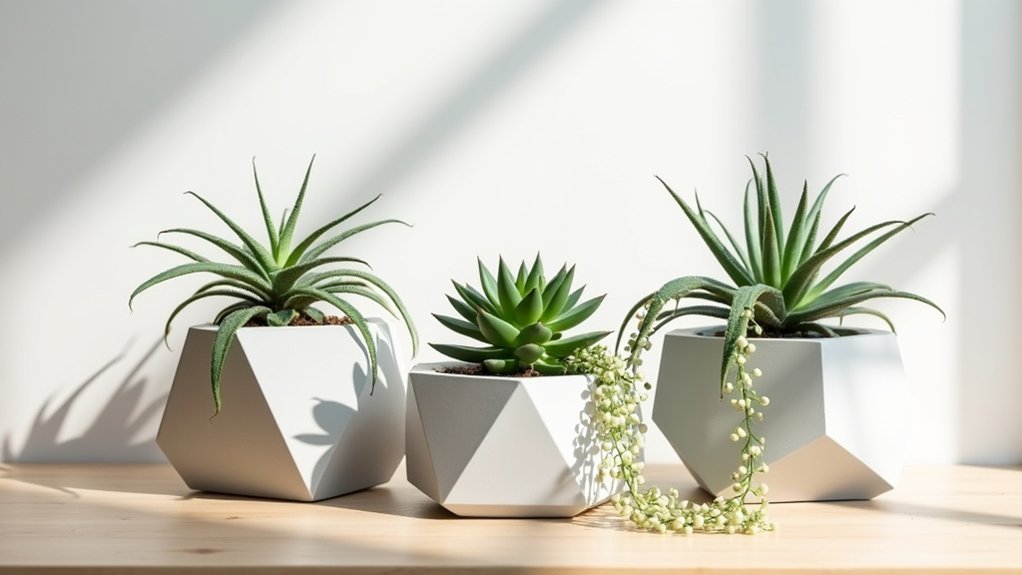
Handcrafted cement planters blend industrial chic with contemporary design, featuring clean lines, geometric shapes, and smooth surfaces that complement modern décor.
These durable containers often showcase minimalist patterns, textured finishes, or color variations achieved through pigments mixed into the cement. Their substantial weight provides stability for larger plants, while their porous nature allows proper air circulation to root systems.
Growing Conditions:
- Place in areas protected from extreme temperature fluctuations to prevent cracking
- Ensure adequate drainage holes to avoid water pooling
- Use a well-draining potting mix suitable for the specific plants
- Position according to individual plant light requirements, as cement planters work with both sun and shade-loving species
- Allow soil to dry slightly between waterings, as cement can retain moisture
To maintain cement planters in optimal condition, regularly inspect for hairline cracks and seal them promptly with appropriate concrete patching compounds.
Clean the exterior surface annually with a mild soap solution and soft brush to remove dirt buildup and prevent staining.
During winter months in cold climates, either move planters indoors or wrap them in insulating materials to protect against freeze-thaw damage that could compromise the container’s integrity.
Mixed Metal Containers for Industrial Appeal
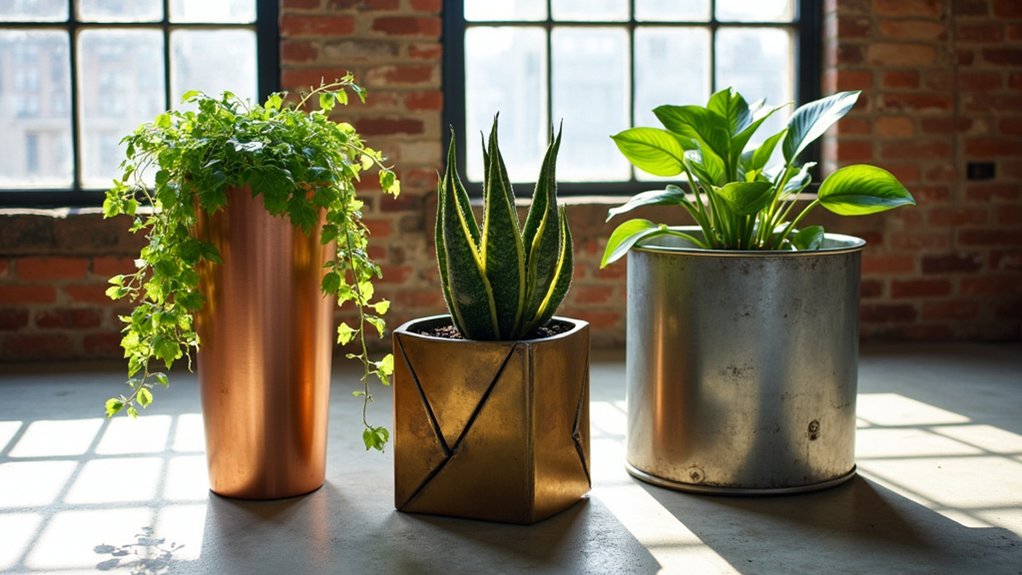
Mixed metal containers combine various metallic finishes like copper, brass, galvanized steel, and weathered iron to create an edgy, industrial-chic aesthetic for indoor and outdoor plants.
These containers often feature raw, unpolished surfaces, riveted edges, or welded seams that add character and visual interest. The combination of different metal tones and textures creates a sophisticated urban look while providing durable, long-lasting homes for plants.
- Light Requirements: Most metal containers can withstand full sun to partial shade, though dark-colored metals may heat up significantly in direct sunlight.
- Water Needs: Requires drainage holes to prevent water pooling; metal doesn’t absorb moisture like clay pots.
- Soil Conditions: Well-draining potting mix recommended to prevent root rot.
- Temperature: Metal conducts temperature readily; protect roots from extreme heat/cold.
- Size Selection: Choose containers at least 2-3 inches larger than the plant’s root ball.
- Material Compatibility: Avoid mixing reactive metals that could corrode when in contact.
To maintain mixed metal containers, regularly inspect for signs of rust or corrosion, particularly at seams and drainage holes.
Apply a clear protective sealant annually to prevent oxidation, and place protective feet or risers under outdoor containers to prevent surface staining.
During extreme weather, consider moving containers to sheltered locations, as metal can quickly transfer damaging temperature fluctuations to plant roots.
Clean containers with a gentle, non-abrasive cleaner to preserve their patina while maintaining their industrial appeal.
Vintage-Inspired Terracotta Collections
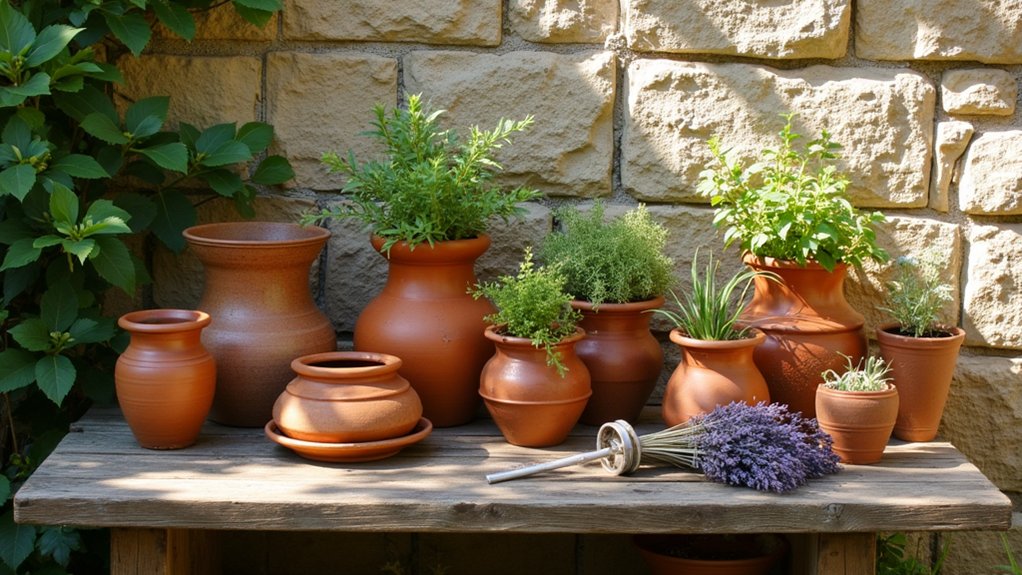
Vintage-inspired terracotta collections bring timeless Mediterranean charm to any space through their warm, earthy tones and weathered patinas.
These collections typically feature pots of varying sizes and designs, from simple cylindrical shapes to ornately detailed vessels with aged finishes, cracks, and moss growth that create an authentic antique appearance.
The natural porosity of terracotta combined with classic European styling makes these collections particularly suited for both indoor and outdoor display arrangements.
Growing Conditions:
- Place in bright, indirect light for indoor use; can tolerate full sun outdoors
- Allow soil to dry between waterings due to terracotta’s moisture-wicking properties
- Use well-draining potting mix to prevent water accumulation
- Maintain temperatures between 60-80°F (15-27°C)
- Provide adequate spacing between pots for air circulation
- Consider pot size based on plant root systems
To preserve the aesthetic appeal and functionality of vintage-inspired terracotta collections, seal untreated pots with a clear waterproof sealant to prevent excessive moisture loss and mineral buildup.
Clean pots annually with a gentle brush to remove salt deposits while maintaining the desired patina.
During winter months, move outdoor collections to a protected area to prevent freeze damage, and elevate pots off the ground using pot feet or stands to ensure proper drainage and prevent staining on surfaces.
Geometric Pattern Ceramic Pots
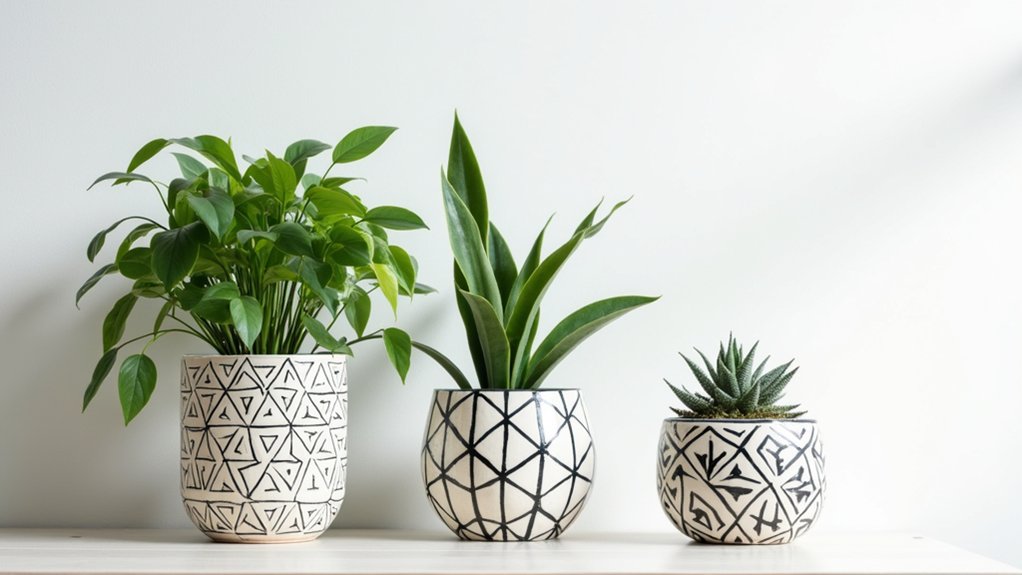
Geometric pattern ceramic pots combine modern design aesthetics with functional plant housing, featuring bold angular shapes, repeating patterns, and clean lines etched or painted onto the ceramic surface.
These decorative containers often showcase triangles, hexagons, diamonds, or abstract geometric designs in monochromatic or contrasting color schemes, making them striking accent pieces for any indoor or outdoor space while providing a stable environment for plants to grow.
- Place in areas with indirect sunlight to prevent the ceramic from overheating
- Ensure proper drainage holes are present to avoid water pooling
- Use well-draining potting soil appropriate for the specific plant
- Maintain consistent moisture levels, as ceramic retains water longer than other materials
- Keep pots at room temperature, avoiding extreme temperature fluctuations
- Position away from direct heat sources or cold drafts
Regular maintenance of geometric pattern ceramic pots involves gentle cleaning with a soft, damp cloth to preserve the design and prevent dust accumulation.
Inspect the drainage holes periodically to ensure they remain clear and unclogged, and rotate the pot quarterly to promote even plant growth.
When repotting, handle the container with care to avoid chipping or damaging the geometric patterns, and consider applying a clear sealant every few years to protect the design if it’s painted rather than etched.
Hanging Woven Basket Planters
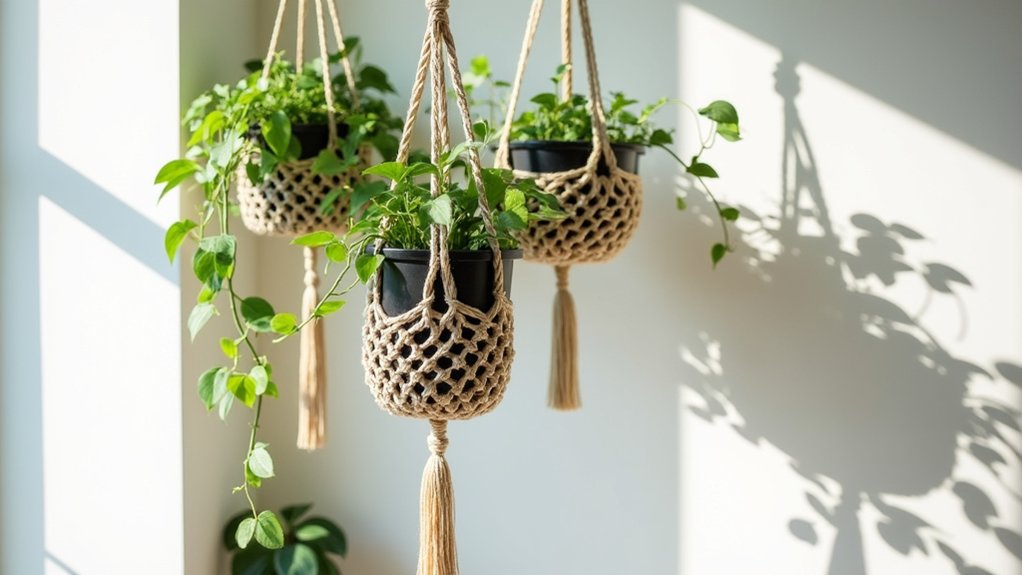
Woven basket planters suspended from ceilings or wall hooks combine natural textures with vertical gardening appeal.
These decorative containers, typically crafted from materials like rattan, seagrass, or macramé, feature an open-weave design that adds bohemian charm while allowing air circulation around plants. The baskets often come with sturdy hanging cords or chains and may include plastic or metal liner inserts to protect the woven material from moisture.
Growing Conditions:
- Position in bright, indirect light unless specified otherwise by specific plant needs
- Choose a spot away from heating/cooling vents to prevent temperature fluctuations
- Ensure proper drainage with holes in liner or insert
- Use lightweight, well-draining potting mix
- Monitor soil moisture more frequently as hanging baskets dry out faster than ground-level pots
- Maintain moderate humidity levels around the basket
Regular maintenance of woven basket planters involves checking the hanging hardware’s security and inspecting the basket material for signs of wear or water damage.
Rotate the basket quarter-turns weekly to ensure even growth, and trim trailing plants to maintain desired shape.
Clean the exterior of the basket periodically with a soft brush to remove dust, and consider applying a natural protective coating annually to extend the basket’s lifespan.
During seasonal cleaning, lift the plant liner to check for any moisture accumulation in the bottom of the basket that could lead to deterioration.
Minimalist Nordic-Style Vessels
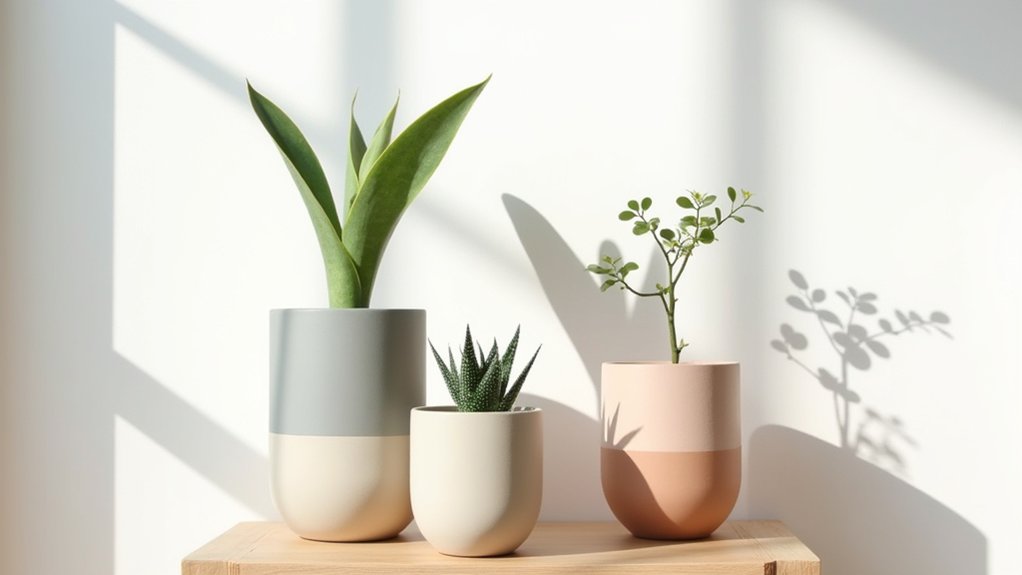
Nordic-style plant vessels embody clean lines, natural materials, and understated elegance typical of Scandinavian design.
These minimalist pots often feature matte finishes in neutral colors like white, gray, or natural clay, with simple geometric shapes and smooth surfaces. Many come with wooden stands or incorporate pale wood elements, creating a perfect balance between warmth and modern simplicity.
Some designs include subtle texture variations or gentle curves while maintaining their characteristic restraint.
- Light: Place in bright, indirect light to prevent pottery from overheating
- Water: Requires drainage holes or inner cache pots to prevent water pooling
- Temperature: Best kept between 65-75°F (18-24°C) to prevent cracking
- Material Care: Wipe with damp cloth; avoid harsh cleaners
- Placement: Keep away from direct heat sources and cold drafts
- Weight Consideration: Fill larger pots with lightweight soil mix to maintain stability
Regular maintenance focuses on preserving the pot’s aesthetic appeal and structural integrity.
Rotate vessels quarterly to ensure even wear and prevent discoloration from sun exposure.
Inspect stands and wooden elements monthly for water damage or wear, applying food-grade mineral oil to wooden components twice yearly.
Clean salt deposits or mineral buildup promptly using a soft brush, and check regularly for hairline cracks that could compromise the pot’s integrity.
Repurposed Antique Container Gardens
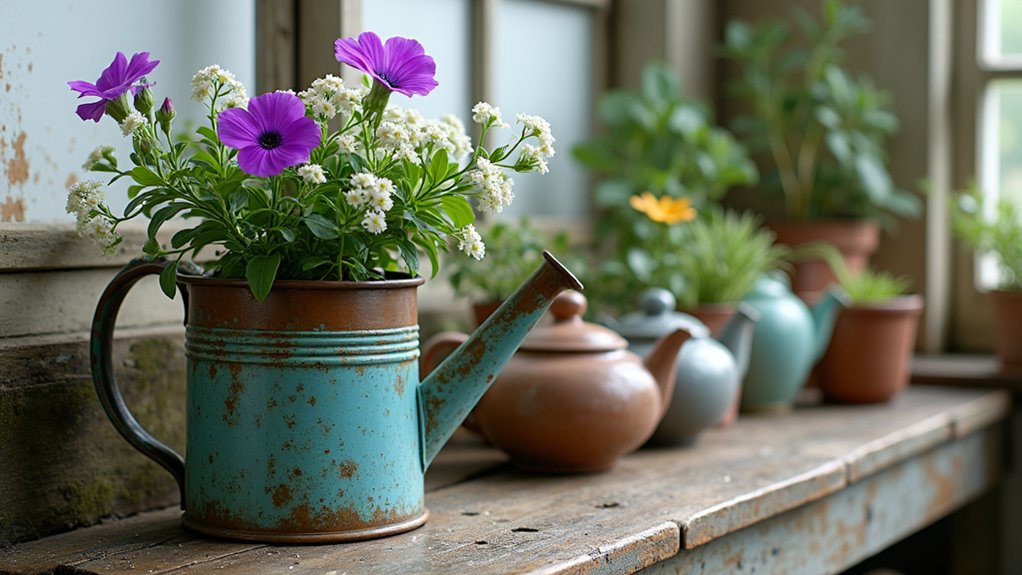
Repurposed antique containers transform vintage treasures like weathered teapots, rustic watering cans, antique trunks, and classic ceramic bowls into charming garden vessels.
These distinctive planters add character and history to any space while giving new life to old items that might otherwise be discarded. The aged patina, unique designs, and nostalgic appeal of antique containers create eye-catching focal points, whether displayed indoors or in outdoor garden settings.
- Light requirements vary by plant selection, but most antique containers work well in partial to full sun locations.
- Drainage holes must be added to non-porous containers to prevent root rot.
- Use lightweight, well-draining potting soil mixed with perlite for proper aeration.
- Container size should match plant needs, allowing room for root growth.
- Place containers on surfaces that won’t be damaged by water seepage.
- Consider container material when placing outdoors – some metals may rust, while ceramics could crack in freezing temperatures.
Regular maintenance of antique container gardens involves checking drainage holes for clogs, inspecting containers for damage or wear, and cleaning the vessels’ exterior surfaces to preserve their vintage appeal.
Apply protective sealants to wooden containers to prevent rot, and remove any developing rust on metal pieces.
When repotting, handle delicate antique containers with extra care to avoid chips or cracks, and consider using plastic liner pots inside more fragile vessels to provide an additional layer of protection while making plant maintenance easier.
Color-Block Statement Pots
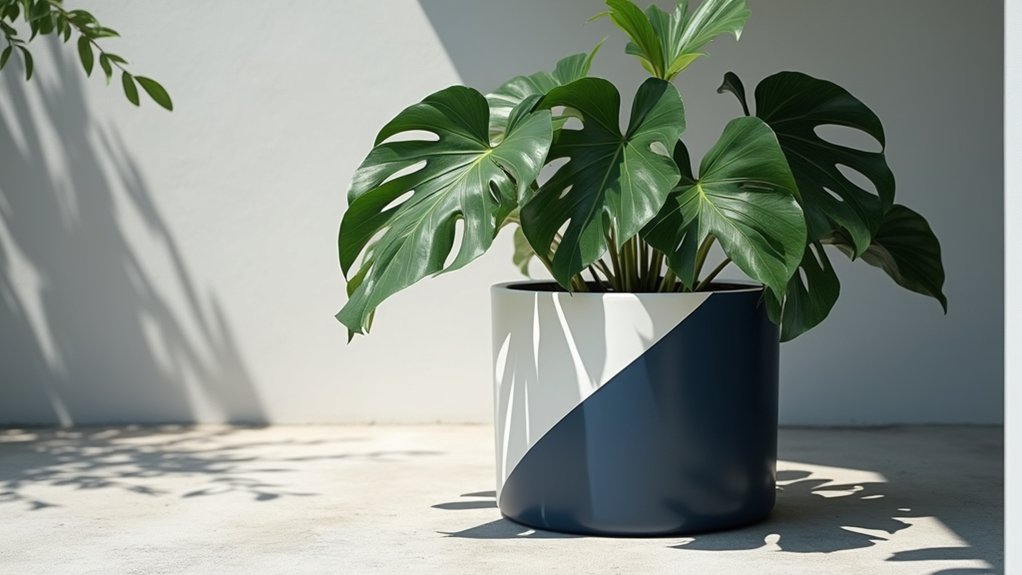
Color-block statement pots combine two or more distinct colors in bold geometric patterns, creating visually striking containers that serve as both plant holders and artistic pieces.
These modern planters typically feature clean lines dividing solid colors, with popular combinations including black and white, pastels with neutrals, or complementary color schemes. The design can be horizontal splits, vertical divisions, or diagonal patterns, making each pot a unique decorative element that draws attention to the plants they house.
- Light exposure: Depends on pot placement; avoid direct sunlight on dark-colored sections to prevent heat absorption
- Drainage: Requires adequate drainage holes to prevent water pooling
- Material compatibility: Best with frost-resistant materials like ceramic or composite
- Paint durability: Select weather-resistant, non-toxic exterior paints
- Size considerations: Choose appropriate pot size for plant root systems
- Temperature regulation: Light colors reflect heat, dark colors absorb it
Regular maintenance of color-block pots involves protecting the painted surfaces from scratches and UV damage by applying a clear sealant annually.
Inspect color transitions regularly for paint peeling or separation, especially in outdoor settings. When cleaning, use gentle soap solutions and avoid abrasive scrubbers that could damage the color blocks.
Position pots away from sprinklers or heavy rain splash to preserve the crisp lines between colors, and rotate them periodically to ensure even weathering of all painted surfaces.
Natural Stone and Crystal Planters
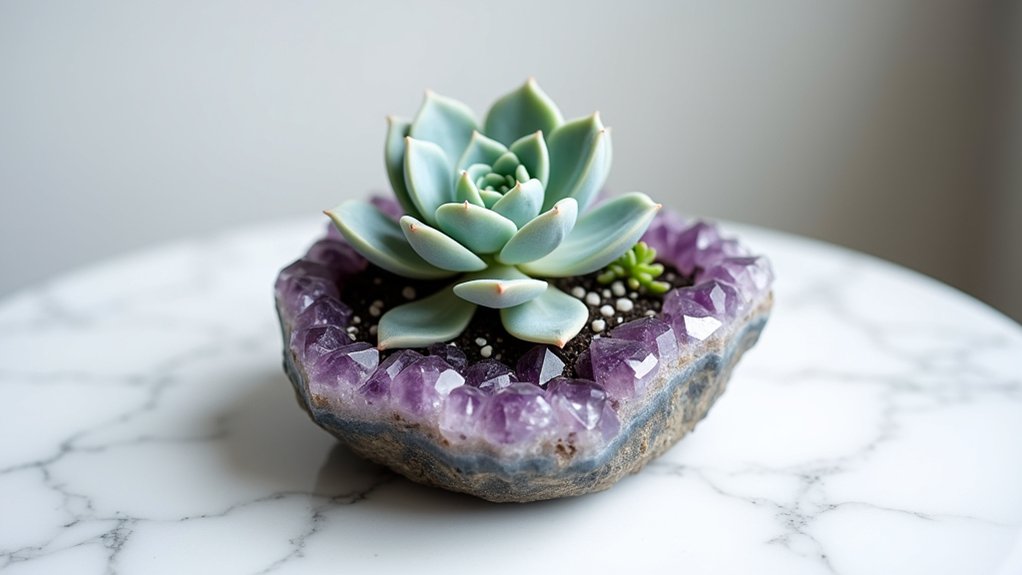
Natural stone and crystal planters bring an organic, earthy elegance to indoor spaces while providing a unique home for plants. These containers range from polished geodes and amethyst clusters to rough-hewn marble and granite vessels, each offering distinct textural elements and natural color variations.
The crystalline structures and mineral compositions create striking visual displays that complement both succulent arrangements and small tropical specimens.
- Light: Place in bright, indirect sunlight to prevent mineral discoloration and protect plant roots from overheating.
- Water: Ensure proper drainage holes or layer of gravel, as natural stone can retain moisture.
- Soil: Use well-draining potting mix appropriate for chosen plant species.
- Temperature: Keep away from extreme temperature fluctuations to prevent stone cracking.
- Size: Select appropriately sized specimens, as stone planters typically can’t accommodate large root systems.
Regular maintenance of stone and crystal planters involves gentle cleaning with a soft, dry cloth to remove dust and maintain the natural luster of the minerals.
Avoid using harsh chemicals or abrasive materials that could damage the stone’s surface. Periodically check the drainage system and bottom of the planter for mineral deposits or salt buildup, which can affect plant health and the container’s appearance.
During seasonal transitions, inspect for any cracks or fissures that may develop due to natural weathering of the stone material.
